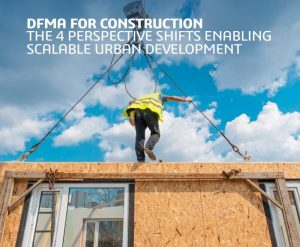The following article is excerpted from DFMA for Construction: The 4 Perspectives Shifts Enabling Scalable Urban Development, a whitepaper developed by Dassault Systèmes. To read more about the shift from trade-based installations to modular assemblies, download the full whitepaper here.
With any off-site construction approach, large physical assets must be somehow dissected into smaller assets to be transported to a site. However, simply carving up a structure by volumetric space does not equate to modularization.
True modularization demands that systems be reengineered with the goal of streamlining the assembly process. It’s about redesigning an asset as a set of components that can be preassembled in a factory and interface fluently.

“You don’t call an electrician to plug your coffee maker into the wall. The interface between components—the appliance and the power source—have been reduced to prongs in an outlet. This can be done for many things in construction. If we rethink the interfaces between the components, anyone could connect the modules.”
– Pierre Guehenneux, Vice President of R&D, Construction, Cities & Territories, Dassault Systèmes
Using modular assemblies, contractors can both accelerate the project timeline and democratize the assembly process so that it can be performed by any population, including unskilled, undereducated, inexperienced and disabled workers.
The reduction and simplification of interfaces between components has the power to drastically reduce the need for skilled labor off site and on site. This shift frees up increasingly scarce and costly tradespeople to be redeployed where they provide more value—at a system level.
Plus, municipalities with a need for higher employment rates are eager to grant building permits to development teams that can tap local labor pools. Project stakeholders who demonstrate to officials that they can employ local populations may gain incentives in addition to resolving workforce challenges.
To achieve democratized assembly, designers must redesign building modules by rethinking how installation can happen. With a modular approach, the assembly phase becomes as important to the designer as the occupant experience.
Reaping the full benefits of modularized assembly requires that certain processes are reengineered and that components are redesigned accordingly:
- Split all assembly processes into the simplest possible tasks.
- Automate anything that can be automated.
- Use tradespeople more efficiently by deploying them only where they are truly needed.
- Design component interfaces to be usable by unskilled laborers.
- Manufacture and pre-assemble components to optimize for accelerated on-site workflows.
The investment in reengineering such processes and components will help reduce the resources required to complete the assembly phase of the project while simultaneously increasing community engagement.
Excerpted from DFMA for Construction: The 4 Perspectives Shifts Enabling Scalable Urban Development, a Dassault Systèmes whitepaper
Download our free whitepaper to learn more.

DFMA has the potential to transform the construction industry. This transformation will gain traction as project stakeholders increasingly discover the cost and time savings DFMA offers. Shifting to modular assemblies demands an initial investment in time spent reengineering processes and the tools and equipment needed to support new components. Companies that lead the change will see greater long-term benefits than those who try to catch up on the later side of the adoption curve.
Related links:
Dassault Systèmes Construction, Cities & Territories Industry
